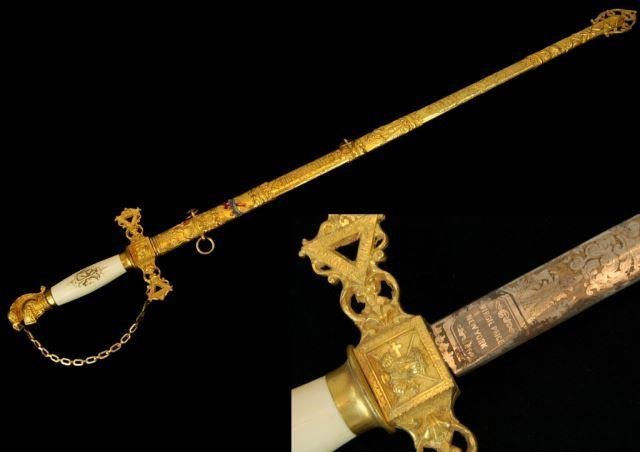What is it about the sword? These fascinating weapons have been popular at auctions for hundreds of years. Antique, historic, even modern works of art can fetch thousands at auction. Many times, it’s their personal history, the weapon’s rarity or just its design. The Japanese Katana or Samurai Sword has always had an air of mystery. The Spanish Rapier conjures up the Three Musketeers. The Saber brings to mind charging into battle.
Swords of historical significance have crossed the auction block before and have sold for staggering amounts. The Confederate Presentation Sword to General Christopher H. Mott realized more than $300,000 at an auction in 2008. Major General John E. Wool’s sword sold for $575,000. The 1812 Presentation Sword of General Winfield Scott brought $1.7 million at the same auction in 2008. So you can see, the swords can mean serious business both as a weapon and as an auction draw.
Over the years, I’ve seen all types all types of swords, daggers and knives auctioned off. I think there will always be a fascination with historic swords, especially since there were less of them made. Here are some tips if you’re new to collecting.
3 Tips for Collecting Swords
1.) Know the difference between decorative and functional swords. Decorative swords were often made with stainless steel, which can easily fracture or break under high impact. Functional swords were made with a variety of different steels, including Damascus and folded steel. Most functional swords weigh between two and four pounds and were designed to flex and bend.
2.) Research the era in which the sword was produced. As with any collectible, there are many reproductions on the market, and even some original swords that have been restored in some way. Check out Old Swords, MyArmoury.com and other resource sites.
3.) Examine markings and rust stains. Markings can range from country of origin, maker’s marks, inspector stamps, arsenal marks and more. And sometimes, the lack of a date or mark can help authenticate it. If there is blood on a sword, any contact with water will make it bleed red, even after thousands of years, whereas regular rust will turn brown.
As for what to budget, some of the more modern swords are reasonable. Recently, here in Arizona, a 20th century Japanese Samurai Wakizashi sword realized $1,320 at auction. And a few years back, an Ikkansai Kasama Shigetsugu tanto, or short sword, sold to an internet bidder for $3,250. More reasonably, a 19th Century Masonic Dress Sword sold for $170 and a Civil War Era Calvary Sword brought $300. So as you can see, getting in to some of these won’t completely break the bank.
Once you start collecting swords, you’ll probably find yourself hooked, especially if you’re lucky enough to find a rare one.
LINKS TO STALK / FOLLOW JOSH
SUBSCRIBE to My YOUTUBE Channel: https://bit.ly/2PgAEPJ
My Website & Blog: https://www.joshlevinespeaks.com
Buy My Book: https://amzn.to/31rOpzc
Follow me on INSTAGRAM: https://www.instagram.com/joshlevinespeaks
Like me FACEBOOK page: https://www.facebook.com/joshlevinespeaks
Follow Me on PINTEREST - https://www.pinterest.com/jlevines1/
Follow Me on TUMBLR - https://joshlevinespeaks.tumblr.com/




Comments